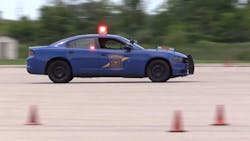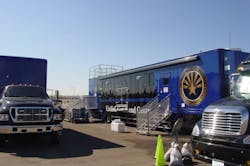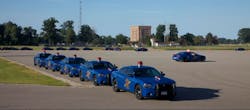On the Right Track: Driver Training for Law Enforcement Agencies
Public safety training facilities take countless hours to plan, millions of dollars to build and in the end can take up dozens of acres of land. While not all training facilities include driver training tracks, the advantages of having a track on site are countless. Academy recruits can stay at the facility instead of having to be shuttled to another location and current officers can go through advanced training at the same location.
We recently spoke with Glendale Police Lt. David Vidaure about the Glendale Regional Public Safety Training Center in Arizona that he helps oversee, and with Michigan State Police Lt. Mike McCarthy, who heads up the agency’s Precision Driving Unit at the Michigan State Police Training Academy in Lansing.
They offered tips for both agencies looking to building a new training facility and for those considering adding a driving track to an existing facility.An adaptable design
In Glendale, the $45 million training center—also known as GRPSTC—was built on 56 acres of land and opened in April of 2007 as a partnership between multiple agencies. The facility is run by the city and is shared by the police and fire departments. Vidaure noted that the driving track is re-asphalted every 15 years with a slurry seal done every 7. The agency just completed its first asphalt replacement.
The way the track was built was as a wide-open configurable space rather than a typical racing car track with dedicated roadways with curves or turns. “It can be configured in whatever manner necessary for training whether it is doing things like a pursuit course or for recruits to learn how to drive with emergency lights or sirens or evasive lane changes,” says Vidaure. “There are also times when our motor officers have used it for new motorcycle officer training as well as their quarterly in-services.”Agencies are allowed to maintain markings on the surface of the track to place cones, so the different layouts do not have to be reimagined every time they set up. The Glendale Fire Department also uses the space for its fire academy, which runs year-round. They drive full-size engines out onto the driving track while the police department uses it for its patrol vehicles and motorcycles. Before the facility was opened, the Glendale Police Department would use various facilities to fit its needs. When Vidaure was in the police academy in 2003, the department used a facility owned by the City of Phoenix. “It was quite the drive to get there and in order to use it there had to have been a request made,” he says, adding that his motorcycle training was held on Luke Airforce Base on a runway and that the training had historically been held at a local mall. “Wherever you could find the space to use for the three weeks that you needed it, you could put in and request it.”
Vidaure helps determine the curriculum each year for the agency’s mandated advanced officer training conducted annually and there is usually one component related to driving every year based on needs and historical issues. With the use of the track, these are things they are able to address and build into the curriculum.
While there have been plans drawn up to add on to the existing training facility, none of the plans have altered the design of the driving track. The track also includes a concrete skid pad for additional training for police vehicles and on the fire side. “The idea behind making it sort of open, flat and configurable as it is, was to make it adaptable and multiuse,” he says. “To have the adaptability is nice to have the clean slate that we do versus a dedicated course where it’s not configurable for other vehicles or equipment.”
The facility has hosted events and served as a staging area when the Super Bowl was hosted in the city’s stadium in 2015, which is located about 2 miles away from the facility. “It’s not only a driving track, but it’s turned out to be a very useful space for other events or things that we have to do that need a large open space,” he says. “Even a regular parking lot at a retail facility with medians and light poles and stuff puts limits on what you can do with it. Out here we’ve got a huge blank slate and we can do whatever we need to.”A focused approach
The Precision Driving Facility is located on a 42-acre site adjacent to the Michigan State Police Training Academy. It has a 1-mile road course, a 9-acre maneuvering pad and a 3-acre skid pad. It has been in operation since 1990. Michigan State Police has been training pretty much the same program since its inception. Some things have changed when it comes to the technology in the vehicles, but it is still very close to the original car handling course that was taught when it was first opened.
Recruits are there for a full week when they go through the academy. That includes night pursuit scenarios. The training also involves leaving the campus to go to the Fiat Chrysler Automobiles’ (FCA’s) Chelsea Proving Grounds to do high-speed training on their oval since the top speed at the training track is 80 mph.
With a facility that is more than 30 years old, maintenance is key. According to McCarthy, the driving track it is repaved about every 10 to 15 years. “For maintenance on the vehicles, we’re very fortunate that our state garage is about 2 miles away. Tires, brakes and routine maintenance is dealt with by them. We do have twice as many cars as we need for a week and we will have Week 1’s cars in for maintenance when we have Week 2 and we have a second set of cars for Week 2, so we rotate every week.”
McCarthy says that the facility offers a lot when it comes to driving training and that while many facilities have just a maneuvering pad, which is also used for skid control, the Precision Driving Facility has both, along with a road course. “Ours is a very nice facility for teaching almost everything that we would teach other than the high-speed stuff,” he says.Planning ahead
McCarthy advises agencies to take note from what other departments have done with their training tracks. “Travel around the country and look at other people’s facilities and see what you like and what you dislike,” he says, adding that agencies need to consider what their needs are compared to other departments. A city police department may need to focus on parallel parking while another may focus on driving on freeways.
Vidaure stresses that when it comes to planning a driver training track, agencies must consider their future needs and leave room to adapt. “One of the important things is to look forward and not only look at what your needs are at that time because of process of conception and planning and construction takes years so by the time it comes to fruition, you may have different needs than when you first came up with the plan,” he says. “Consider the different vehicles and other uses you may use the track for. When we first opened the facility, we all drove Crown Victorias. Now we have zero and we’re driving Tahoes and we just got in our first patrol-ready full-size Chevy pickup truck.”
About the Author
Paul Peluso
Editor
Paul Peluso is the Managing Editor of OFFICER Magazine and has been with the Officer Media Group since 2006. He began as an Associate Editor, writing and editing content for Officer.com. Previously, Paul worked as a reporter for several newspapers in the suburbs of Baltimore, MD.





